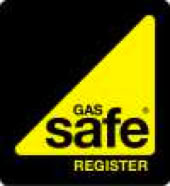
Mike the Boilerman -
Gas Safe Registered boiler and central heating repair technician in west Berkshire

Mike the Boilerman -
Gas Safe Registered boiler and central heating repair technician in west Berkshire
N.B. This page relates to central heating systems, not hot water systems, where there a similar but different question crops up (open-vented or mains-pressure?)
This page is an explanation of the two different methods of filling, and keeping filled, a central heating system:
Open-vented central heating is where you have a 'header tank' in the loft which fills the boiler and radiator system initially and keeps it topped up with water on a long-term basis to replace losses form evaporation and/or minor leaks. A float valve in the tank (more correctly called a 'feed and expansion tank', F&E tank) and connected to mains water keeps the water level in the tank and the heating system correct. The primary advantage of an open-vented system is that no user intervention is required to keep the system topped up with water.
Common problems that occur with 'open vented' systems:
1) Float valve seizes up and sticks closed. Then as the months and years pass by, the water level in the F&E tank drops to nothing, and then the water level in the heating system proper falls. Eventually there isn't enough water for the pump to pump and the system stops working. Sometimes boiler banging noises also happen, and tripping of the boiler over-temperature thermostat. Easily fixed by freeing off the float valve and re-filling the system.
2) Cold fill pipe blocks. This is more common that you might first think. The tee piece where the cold fill pipe joins the system proper accumulates corrosion deposits and they form a rock-like blockage which results in similar symptoms to 1), except the F&E tank remains full of water! The fix is to cut out the tee and solder in a new one.
3) 'Pumping over'. This is where water discharges from the open vent pipe into the F&E tank when the pump is running. This is a Bad Thing because firstly it indicates either incorrect pipework design, or accumulation of corrosion deposits around the cold fill tee, secondly because it causes constant re-oxygenation of the circulating water which accelerates internal corrosion, and thirdly because the F&E tank gets hot and may collapse, and fourthly because it fills the loft with steam!
Sealed-system (sometimes known as 'pressurised') central heating is where the F&E tank is dispensed with and replaced with FAR more complicated and prone-to-failure apparatus. (Can you guess which of the two systems I prefer? ;-) ) Because the F&E tank is no longer available to accommodate expansion in the water contained in the system when it heats up, an expansion vessel is fitted instead. This is a sealed container fitted with a compressible air bladder connected to the heating circuit, and is often fitted inside the boiler.
The second device needed is a method of initially filling the system, and topping it up if/when the system pressure degrades to zero. This is called a 'filling loop', and is usually a silver-braided length of flexible pipe about 12" long which bridges from a mains cold water pipe to a heating circuit pipe, and has valves on both ends. The installer or user turns on the valves to manually fill the system, and turns it off again when filled and the pressure set correctly, and strictly speaking should disconnect the loop (but nobody ever does). There will be a pressure gauge on the system somewhere so the user can see to turn off the filling loop when the system is filled to the right degree, but it will not necessarily be next to the filling loop!
The third device required is a pressure relief valve (PRV). This opens should the system pressure ever rise dangerously high to prevent busting of pipes, radiators etc. It discharges excess pressure through a pipe to outside.
Problems that occur with 'sealed systems': (long section!)
1) System pressure loss. Most (although not all) heating systems lose water from tiny leaks in the system. This means the system pressure gradually degrades to zero over a (hopefully) long period of time. (1.0 bar is generally considered the 'correct' system pressure.) The speed of the fall to zero depends of the rate of leakage. Once zero pressure has been reached then the leaks can work the other way, letting air in when the system cools rather than water out when it heats. This leads to air in the rads and eventually the pump and heat exchanger and damage to the boiler can result. The user is supposed to keep an eye on the system pressure gauge and top it up periodically to 1.0 Bar using the filling loop. (Hands up who knew that!)
To prevent boiler damage from air entrainment, some boiler models (combis especially) have an internal pressure switch that turns the boiler OFF should the system pressure fall near zero. Naturally many users interpret this as a boiler breakdown and call a boiler engineer around only to find they could have saved the call-out charge had they realised they could top it up themselves.
2) System pressure loss. This time the pressure loss is for a different reason. The expansion vessel has stopped working. The boiler fires and heats up the system water. The expansion vessel is not able to accommodate the increase in volume of the system contents and the pressure rises significantly. When the pressure gets to 3.0 Bar the automatic pressure relief valve opens and allows however much water is necessary to escape to prevent pressure rising above 3.0 Bar. When the system cools later, the pressure therefore drops below 1.0 Bar because there is less water in the system. The boiler pressure switch (if there IS one) turns the boiler off until someone re-pressurises the system.
Expansion vessels generally stop working for any of three reasons. The air charge may have leaked away through the car-tyre type valve used for pumping them up in the first place, the neoprene bladder may have perished and leaked it's air into the circulating water, or the flexible hose connecting it to the system may be blocked with corrosion deposits.
3) Excess system pressure. This shows up as water dribbling constantly from the pressure relief valve discharge pipe and a reading on the pressure gauge of 3.0 Bar. It's nearly always caused by the user not disconnecting the filling loop after use, which disguises failure of the filling loop valve to turn off properly. The system continues to work perfectly well but the constant refreshment of the circulating water with new, oxygen-saturated water leads to rapid and expensive-to-repair internal system corrosion, and early failure of the pressure relief valve.
A less common cause of the same problem in combi boilers is an internal leak inside the plate heat exchanger that heats the tap water. Mains pressure forces mains water through the leak into the heating system water and out through the PRV. A new plate heat exchanger is necessary.
So which is best? Open-vented in my view, hands down. But Sealed systems have their uses. Flats, for example, where finding a high, accessible location for an F&E tank can be a headache, and houses with loft conversions too, where similar problems occur. The F&E tank needs to be higher than the top of the highest rad in the system, and it needs to be accessible for maintenance and have a continuously falling route to outside for the overflow pipe.
If you like what I write, please Buy me a coffee. Thank you kindly!

Copyright Michael Bryant 2025
Site first published 16th January 2004
Site last updated 13th November 2025
Gas Safe Register 197499, CIPHE registration number 009909L

This website makes use of cookies. Please see my privacy policy for details.